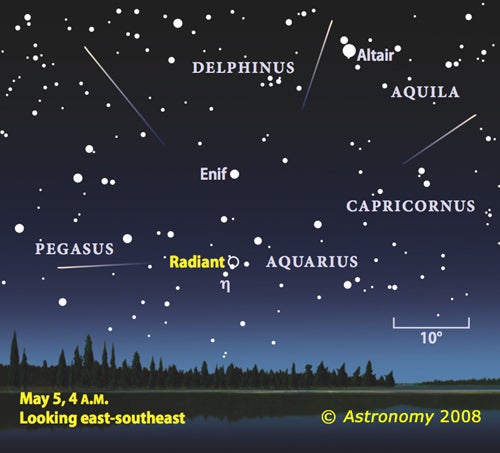
WAUKESHA, WI — Early commuters should be on the lookout for a rush of meteors before dawn May 5. That’s when the annual Eta Aquarid meteor shower reaches maximum activity. The Moonless night offers near perfect conditions to view the meteor shower, and astronomers think the Eta Aquarids could produce more than twice the usual number of meteors.
Video: “How to observe meteor showers,” with Astronomy magazine Senior Editor Michael Bakich.
Podcast: Senior Editor Frank Reddy prepares listeners for the 2008 Eta Aquarid meteor shower.
For more information about this event, or to schedule an interview with an Astronomy magazine editor, please contact Matt Quandt at 262.798.6484 or mquandt@kalmbach.com.
Meteors are fleeting fiery trails — “shooting stars” — that occur as small solid particles burn up in Earth’s atmosphere. Comets shed dust as ice boils off their surfaces and litter their orbits with debris. Meteor showers result when Earth grazes a comet’s dusty path and passes through some of these particles. Dust shed by Comet 1P/Halley creates the Eta Aquarid shower, so named because the meteors seem to emanate from a common point, or radiant, near the star Eta in the constellation Aquarius.
“Meteor-watching is a minimalist activity,” explains Astronomy Senior Editor Francis Reddy. There’s no equipment required — skygazers just need to know when and where to look.
“Dress warmly, relax in a comfortable chair, and keep an eye on the southeastern sky,” he says. “It’s kind of like fishing.”
Astronomy‘s mission:
Astronomy promotes the science and hobby of astronomy through high-quality publications that engage, inform, entertain, and inspire.
More resources from Astronomy.com:
- Astronomy news
- Astronomy basics
- Glossary of astronomical terms
- Return to Astronomy “For the media” page
Catch a falling star
The Eta Aquarid shower is best for Southern Hemisphere observers, so the view gets worse the farther north you go. In the United States, the radiant stands only about 15° high in the southeast at 4 a.m. local daylight time. This low altitude will cut the number of visible meteors significantly. Even so, observers can expect a nice show.
The shower produces pleasingly fast and often bright meteors. “About 30 percent of the meteors leave behind dimly glowing trails called persistent trains. Some can be seen for as long as a minute,” Reddy says.
Although the radiant’s low altitude reduces the number of observable meteors for northern observers, there is compensation. From the United States, Eta Aquarid meteors tend to follow long paths across the sky.
In Halley’s dust
Astronomers give a shower’s meteor rate using numbers that express the number of meteors seen each hour by an observer viewing under a clear, dark sky when the radiant is overhead. In most years, by this measure, the Eta Aquarid shower rates 30 meteors per hour. “But the radiant never gets overhead before dawn, so observers typically will see far fewer meteors,” Reddy explains.
This year, however, the rate could more than double. Studies suggest the shower’s rates rise and fall in a 12-year cycle. “This period hints that Jupiter, the solar system’s largest planet, is affecting the debris that creates the shower,” he says.
Jupiter orbits the Sun in just under 12 years. Every time it passes closest to the Eta Aquarid track, the orbiting particles feel an extra-strong tug. This results in a wavy track that sometimes places extra dust in Earth’s way.
Links for more information on meteor showers:









